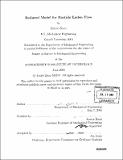| dc.contributor.advisor | Anette Hosoi. | en_US |
| dc.contributor.author | Zhou, Junjie, 1979- | en_US |
| dc.contributor.other | Massachusetts Institute of Technology. Dept. of Mechanical Engineering. | en_US |
| dc.date.accessioned | 2005-06-02T19:19:34Z | |
| dc.date.available | 2005-06-02T19:19:34Z | |
| dc.date.copyright | 2004 | en_US |
| dc.date.issued | 2004 | en_US |
| dc.identifier.uri | http://hdl.handle.net/1721.1/17955 | |
| dc.description | Thesis (S.M.)--Massachusetts Institute of Technology, Dept. of Mechanical Engineering, 2004. | en_US |
| dc.description | Includes bibliographical references (p. 133-138). | en_US |
| dc.description.abstract | The flow of thin liquid films on solid surfaces is a significant phenomenon in nature and in industrial processes where uniformity and completeness of wetting are paramount in importance. It is well known that when a clear viscous fluid flows down an inclined surface under gravity, after some time, the initially straight contact line becomes unstable with respect to transverse perturbations. Clear fluid is easier to use in experiments, but industrial processes usually involve particulates in the form of either suspensions or dry granular flows. In this work, we study the flow of a thin film down an inclined plane. The particle-fluid mixture is modeled as a single fluid with effective density and viscosity, depending on the concentration of the particles. Since the flow is slow and the fluid layer is very thin, inertial effects are ignored and a lubrication approximation is applied to simplify the analysis. It is assumed that there is no variation in the transverse direction before the onset of instability, and the fluid properties and velocity are depth averaged to remove the height-dependence. The settling velocity of the particles is hindered by the presence of neighboring particles; this phenomenon is captured by the hindered velocity function that decreases with increasing concentration. The normal component of the settling velocity is neglected in this work and the resulting model is a system of two equations accounting for the film thickness and particle concentration changes as the mixture flows down the plane. Numerical simulations are performed and it is found that the mixtures with higher concentration flow more slowly. Compared to the clear viscous fluid, particle laden flow results in a bump that is much bigger and the size of the bump | en_US |
| dc.description.abstract | (cont.) bump increases with concentration. We also observe that the front edge of the bump travels faster than the trailing edge and the bump width increases. Numerical simulations reveal that an intermediate plateau structure due to the presence of particles is formed behind the smaller bump due to surface tension. This intermediate state depends on the inclination angle and the initial concentration. When the higher order terms in our derived model are dropped, we discover that the resulting reduced model is still able to capture the bulk characteristics of the flow. The reduced model is a 2X2 system of conservation laws, in which the solutions can be obtained through classical shock theory analysis. It is found that our system involves a 1-shock at the trailing edge connected by an intermediate state to a 2-shock at the leading edge. The intermediate state as well as the shock speeds can be solved by shock theory analysis, and their values are found to agree very well with the simulations. | en_US |
| dc.description.statementofresponsibility | by Junjie Zhou. | en_US |
| dc.format.extent | 138 p. | en_US |
| dc.format.extent | 7055544 bytes | |
| dc.format.extent | 7055352 bytes | |
| dc.format.mimetype | application/pdf | |
| dc.format.mimetype | application/pdf | |
| dc.language.iso | eng | en_US |
| dc.publisher | Massachusetts Institute of Technology | en_US |
| dc.rights | M.I.T. theses are protected by copyright. They may be viewed from this source for any purpose, but reproduction or distribution in any format is prohibited without written permission. See provided URL for inquiries about permission. | en_US |
| dc.rights.uri | http://dspace.mit.edu/handle/1721.1/7582 | |
| dc.subject | Mechanical Engineering. | en_US |
| dc.title | Reduced model for particle laden flow | en_US |
| dc.type | Thesis | en_US |
| dc.description.degree | S.M. | en_US |
| dc.contributor.department | Massachusetts Institute of Technology. Department of Mechanical Engineering | |
| dc.identifier.oclc | 56889308 | en_US |
